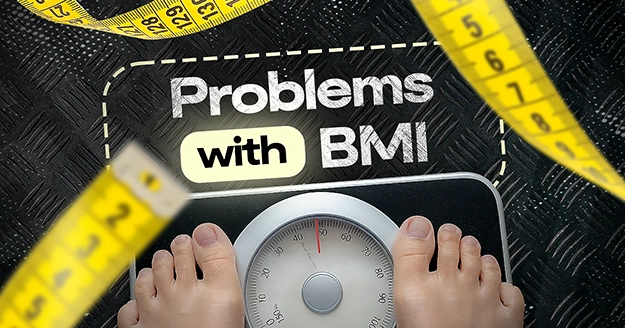What is BMI?
Body Mass Index or BMI is calculated by dividing an individual’s weight in kilograms (or pounds) by the square of height in centimeters (or feet). A high BMI can indicate high body fat content.
Your BMI is considered “underweight” if it is below 18.5. Your BMI falls into the “healthy weight” range if it is between 18.5 and 24.9. Your BMI is considered “overweight” if it is between 25.0 and 29.9. Your BMI is considered “obese” if it is 30.0 or greater.
However, there are some BMI issues you need to know. Let’s get started.
Problem #1: BMI ignores body composition.
The problem with BMI is that it is solely based on weight and height and does not consider the body’s proportion of fat, muscle, skeletal tissue, and water content.
This means that a highly muscular person may be classified as overweight or obese, even if they have a low percentage of body fat.
A cubic inch of muscle weighs more because it is denser than a cubic inch of fat. BMI will, therefore, unavoidably classify muscular, athletic persons as being fatter than they actually are.
For example, a person who doesn’t exercise but has the same height and weight as a 6ft tall, 90kg (200lbs) Olympic 100-meter sprinter may have the same BMI (26) as the latter.
Both of them would be considered overweight based on their BMIs.
Problem #2: BMI exaggerates thinness in short people and fatness in tall people.
BMI calculation is based on weight and height alone and does not account for differences in body proportions.
Shorter individuals tend to have lower BMIs for a given level of body fat because they have less height to spread their weight across. Conversely, taller individuals may have higher BMIs even if they have a similar body composition because their weight is distributed over a greater height.
Problem #3: A BMI of “overweight/obese” does not necessarily indicate health problems.
Multiple factors influence health risks, including diet, physical activity, genetics, and overall lifestyle.
Health risks are not solely determined by weight; other factors like waist circumference, blood pressure, cholesterol levels, and blood sugar also play a significant role. Some people with a “normal” BMI may have health problems, while others with a higher BMI may have no significant health issues.
Conversely, it’s possible for someone with a higher BMI to be metabolically healthy if they have good eating habits and are physically active.
Problem #4: It doesn’t account for cultural and ethnic variations.
Different populations may have body composition, bone density, and fat distribution variations. The problem with BMI calculation is BMI was originally developed based on data from a Western population and may not accurately reflect the health status of individuals from different ethnic backgrounds. This can result in misclassifying individuals from certain ethnic groups.
Problem #5: Focusing on BMI ignores behaviors.
Focusing solely on BMI can lead to an oversimplified view of health and may ignore crucial behavioral factors that are vital to a person’s overall well-being.
Diet and Nutrition: BMI doesn’t provide any information about a person’s dietary habits. Good nutrition and a balanced, healthy diet are necessary for maintaining health, regardless of one’s BMI. Overeating or eating unhealthy foods can lead to health problems, even if BMI is within the “normal” range.
Physical Activity: One of the problems with using BMI is it doesn’t account for physical activity. A sedentary lifestyle can contribute to health issues, such as cardiovascular disease and diabetes, regardless of one’s BMI. Regular physical activity is a critical behavior that impacts health, and BMI doesn’t reflect a person’s activity level.
Smoking and Alcohol Consumption: Behaviors like smoking and excessive alcohol consumption have well-documented health risks. These habits can contribute to various diseases, irrespective of a person’s BMI.
Stress and Mental Health: Constant high stress levels and poor mental health can have significant health implications. These behavioral and psychological factors are not considered in a BMI assessment but can greatly affect well-being.
Sleep Patterns: Sleep patterns and quality are vital for health. Poor sleep can lead to various health complications, including obesity and metabolic issues, that may not be reflected in BMI alone.
Preventive Health Measures: Behaviors related to preventive healthcare, such as vaccination, regular check-ups, and early detection of health issues, are not considered by BMI.
Conclusion
It’s important to understand that one of the BMI issues is that it was not designed to be a one-size-fits-all measurement and has its limitations.
Body composition is a critical factor in assessing overall health, and BMI doesn’t provide any information about the distribution of muscle and fat in the body.
BMI can provide a rough estimate, but it should not be the only basis of an individual’s health or body fat level, especially when evaluating people at the extremes of height.
To get a more accurate insight into a person’s health, it’s essential to consider additional measurements, such as body fat percentage, waist circumference, and other health indicators.









